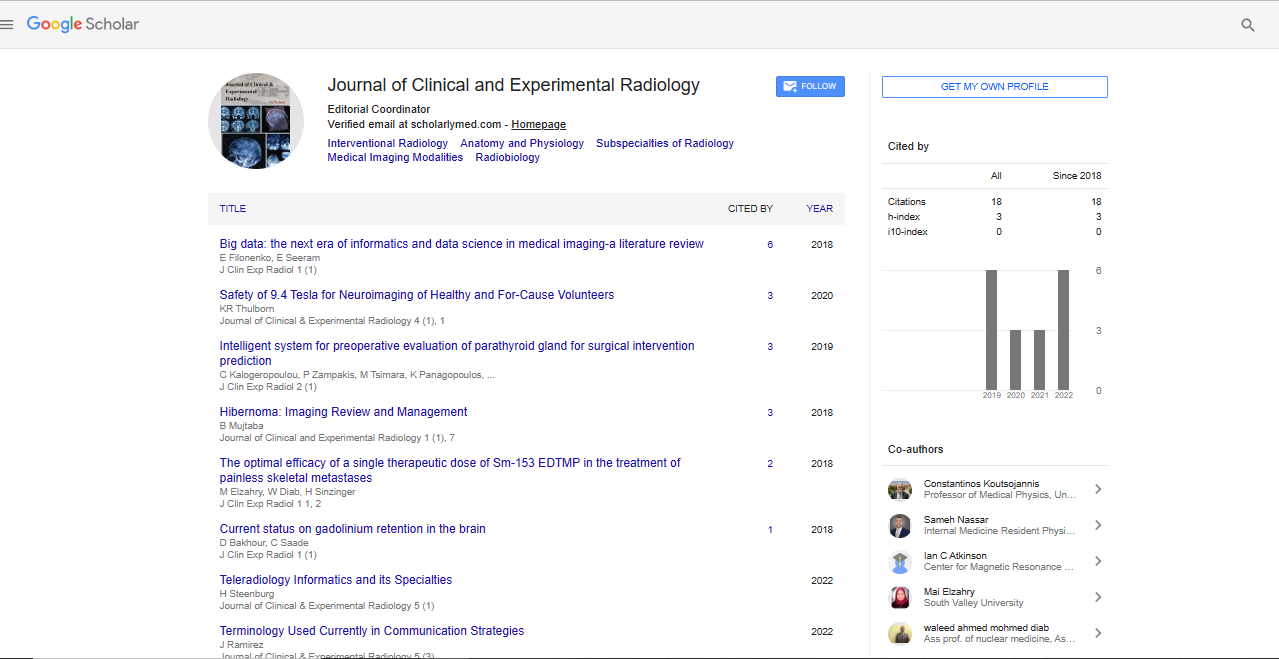Commentary, J Clin Exp Radiol Vol: 6 Issue: 4
Fundamentals of Radiation Physics: Behavior and Properties of Radiation
Seiadel Hefearkap*
1Department of Radiology and Biomedical Imaging, University of New Mexico, Albuquerque, USA
*Corresponding Author: Seiadel Hefearkap,
Department of Radiology and
Biomedical Imaging, University of New Mexico, Albuquerque, USA
E-mail: sehefearkap@gamil.com
Received date: 24 November, 2023, Manuscript No. JCER-24-124142;
Editor assigned date: 27 November, 2023, PreQC No. JCER-24-124142 (PQ);
Reviewed date: 13 December, 2023, QC No. JCER-24-124142;
Revised date: 20 December, 2023, Manuscript No. JCER-24-124142 (R);
Published date: 27 December, 2023, DOI: 10.4172/jcer.1000150
Citation: Hefearkap S (2023) Fundamentals of Radiation Physics: Behavior and Properties of Radiation. J Clin Exp Radiol 6:4.
Description
Radiation physics is a multifaceted branch of physics that explores the behavior and properties of radiation. This manuscript aims to provide a comprehensive overview of radiation physics, covering its fundamental concepts, types of radiation, interactions with matter, and applications in various fields. Radiation, in the context of physics, refers to the emission and propagation of energy through space or a substance in the form of waves or particles. This manuscript focuses on ionizing radiation, which has sufficient energy to ionize atoms and molecules. Understanding the fundamental principles of radiation physics is crucial for various scientific and technological applications.
Types of radiation
Radiation can be categorized into two main types: Electromagnetic radiation and particle radiation.
Electromagnetic radiation: Electromagnetic radiation includes photons with various energy levels. The electromagnetic spectrum spans a wide range, from radio waves to gamma rays. X-rays and gamma rays are particularly important in medical imaging and cancer treatment due to their ability to penetrate matter.
Particle radiation: Particle radiation consists of charged or uncharged particles emitted from a radioactive source. Common examples include alpha particles (helium nuclei), beta particles (electrons or positrons), and neutrons. These particles interact differently with matter, leading to diverse applications in science and industry.
Interactions with matter
Understanding how radiation interacts with matter is essential for predicting its effects and designing appropriate shielding. The main types of interactions include:
Photoelectric effect: In this process, an incident photon ejects an electron from an atom. This interaction is more prominent in materials with higher atomic numbers and is crucial in medical imaging techniques like Computed Tomography (CT).
Compton scattering: Compton scattering involves the deflection of photons by electrons, resulting in a change in the wavelength of the scattered photon. This phenomenon is vital in diagnostic radiography and plays a role in understanding the structure of matter.
Pair production: At high energy levels, photons can produce electron-positron pairs when interacting with matter. This process is central to understanding the behavior of radiation at the subatomic level.
Biological effects of radiation
Exposure to ionizing radiation can have biological consequences, and understanding these effects is critical for establishing safety guidelines. The linear no-threshold model suggests a linear relationship between dose and biological effects, even at low levels of exposure. This model guides radiation protection standards and regulations.
Applications of radiation physics
Radiation physics finds diverse applications across various fields:
Medical imaging and therapy: X-rays, gamma rays, and particle radiation are extensively used in medical diagnostics and cancer treatment. Techniques like X-ray radiography, fluoroscopy, and radiotherapy have revolutionized medical practices.
Nuclear power: Nuclear power harnesses the energy released during nuclear reactions for electricity generation. Understanding the physics of nuclear reactions is crucial for the safe and efficient operation of nuclear power plants.
Industrial applications: Radiation is employed in industrial settings for inspection, sterilization, and material analysis. Radiography, using gamma or X-ray sources, is widely used for nondestructive testing of materials.
Space exploration: Radiation physics plays a crucial role in assessing the risks associated with space travel. Understanding cosmic radiation and its effects on astronauts is essential for planning longduration space missions.
Conclusion
Radiation physics is a dynamic and interdisciplinary field that continues to evolve with advancements in technology and scientific understanding. This manuscript has provided an overview of fundamental concepts, types of radiation, and interactions with matter, biological effects, and applications across diverse fields. As technology progresses, further research in radiation physics will undoubtedly contribute to advancements in medicine, industry, and scientific exploration.
 Spanish
Spanish  Chinese
Chinese  Russian
Russian  German
German  French
French  Japanese
Japanese  Portuguese
Portuguese  Hindi
Hindi 